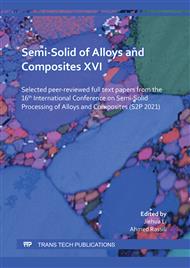[1]
X.X. Dong, X.Z. Zhu, S.X. Ji, Effect of super vacuum assisted high pressure die casting on the repeatability of mechanical properties of Al-Si-Mg-Mn die-cast alloys, J. Mater. Process. Techn. 266 (2019) 105-113.
DOI: 10.1016/j.jmatprotec.2018.10.030
Google Scholar
[2]
X.B. Li, W.B. Yu, J.S. Wang, Influence of melt flow in the gating system on microstructure and mechanical properties of high pressure die casting AZ91D magnesium alloy, Mat. Sci. Eng. A 736 (2018) 219-227.
DOI: 10.1016/j.msea.2018.08.090
Google Scholar
[3]
M.F. Qi, Y.Z. Xu, J.Y. Li, Y.L. Kang, Z. Wulabieke, Microstructure refinement and corrosion resistance improvement mechanisms of a novel Al-Si-Fe-Mg-Cu-Zn alloy prepared by ultrasonic vibration-assisted rheological die-casting process, Corros. Sci. 180 (2021) 109180.
DOI: 10.1016/j.corsci.2020.109180
Google Scholar
[4]
M.F. Qi, Y.L. Kang, J.Y. Li, Z. Wulabieke, Y.Z. Xu, Y.D. Li, A.S. Liu, J.C. Chen, Microstructures refinement and mechanical properties enhancement of aluminum and magnesium alloys by combining distributary-confluence channel process for semisolid slurry preparation with high pressure die-casting, J. Mater. Process. Techn. 285 (2020) 116800.
DOI: 10.1016/j.jmatprotec.2020.116800
Google Scholar
[5]
P.K. Seo, D.U. Kim, C.G. Kang, The effect of the gate shape on the microstructural characteristic of the grain size of Al-Si alloy in the semi-solid die casting process, Mat. Sci. Eng. A 445-446 (2007) 20-30.
DOI: 10.1016/j.msea.2006.06.133
Google Scholar
[6]
Z. Fan, X. Fang, S. Ji, Microstructure and mechanical properties of rheo-diecast (RDC) aluminum alloys, Mat. Sci. Eng. A 412 (2005) 298-306.
DOI: 10.1016/j.msea.2005.09.001
Google Scholar
[7]
P. Mostafa, A.E.W. Jarfors, M. Wessen, Effect of superheat on melting rate of EEM of Al alloys during stirring using the RheoMetal process, Solid State Phenom. 192-193 (2013) 392-397.
DOI: 10.4028/www.scientific.net/ssp.192-193.392
Google Scholar
[8]
D. Doutre, J. Langlais, S. Roy, The seed process for semi-solid forming, Proceedings of the 8th International Conference on Semi-Solid Processing of Alloys and Composites, Limmasol, Cyprus, 2004, pp.1-12.
Google Scholar
[9]
S. Thanabumrungkul, S. Janudom, R. Burapar, Industrial development of gas induced semi-solid process, T. Nonferr. Metal. Soc. 20 (2010) 1016-1021.
Google Scholar
[10]
R.G. Guan, Z.Y. Zhao, R.Z. Chao, J.L. Wen, Research and applications of melt treatment by vibrating sloping plate, Spec. Cast. Nonferr. Alloy. 32(3) (2012) 230-237.
Google Scholar
[11]
X.J. Yang, M. Wang, L.S. Ding, H.M. Guo, X.B. Liu, Squeeze casting of semisolid A356 alloy, Solid State Phenom. 217-218 (2014) 436-441.
DOI: 10.4028/www.scientific.net/ssp.217-218.436
Google Scholar
[12]
W.Z. Zhu, W.M. Mao, Q. Tu, Preparation of semi-solid 7075 aluminum alloy slurry by serpentine pouring channel, T. Nonferr. Metal. Soc. 24 (2014) 954-960.
DOI: 10.1016/s1003-6326(14)63148-4
Google Scholar
[13]
M.F. Qi, J.Y. Li, Y.L. Kang G.N. Li, J.C. Wang, A.S. Liu, J.C. Chen, Integrated technology and application of large volume rheological slurry preparation and high-pressure die-casting. J. Netshape Form. Eng. 12(3) (2020) 12-19.
Google Scholar
[14]
K. Kubota, M. Mabuchi, K. Higashi, Review processing and mechanical properties of fine-grained magnesium alloys, J. Mater. Sci. 34 (1999) 2255-2262.
Google Scholar
[15]
X.G. Hu, Q. Zhu, H.V. Atkinson, H.X. Lu, F. Zhang, H.B. Dong, Y.L. Kang, A time dependent power law viscosity model and its application in modelling semi solid die casting of 319s alloy, Acta Mater. 124 (2017) 410-420.
DOI: 10.1016/j.actamat.2016.11.031
Google Scholar
[16]
M.F. Qi, Y.L. Kang, Y.Z. Xu, Z. Wulabieke, J.Y. Li, A novel rheological high pressure die-casting process for preparing large thin-walled Al-Si-Fe-Mg-Sr alloy with high heat conductivity, high plasticity and medium strength, Mat. Sci. Eng. A 776 (2020) 139040.
DOI: 10.1016/j.msea.2020.139040
Google Scholar
[17]
M.F. Qi, Y.L. Kang, J.Y. Li, B.Y. Shang, Improvement in mechanical, thermal conductivity and corrosion performances of a new high-thermally conductive Al-Si-Fe alloy through a novel R-HPDC process, J. Mater. Process. Techn. 279 (2020) 116586.
DOI: 10.1016/j.jmatprotec.2019.116586
Google Scholar
[18]
M.F. Qi,Y.L. Kang G.M. Zhu, Microstructure and properties of rheo-HPDC Al-8Si alloy prepared by air-cooled stirring rod process, T. Nonferr. Metal. Soc. 27(9) (2017) 1939-1946.
DOI: 10.1016/s1003-6326(17)60218-8
Google Scholar


